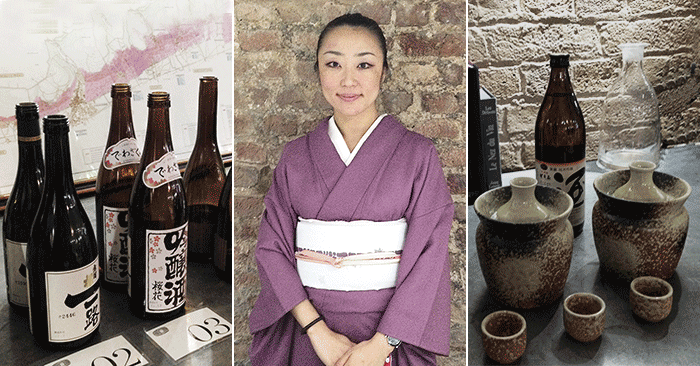How to appreciate sake – a masterclass
Author: Anne McHale MW

Photograph: Asami Tasaka, UK Sales Director of World Sake Imports pictured with some of the sake wines served
Sake is often described as ‘rice wine’ but, in fact, the production process is more akin to brewing beer than vinifying grapes. For sake as with beer, the starch first needs to be converted to sugar before fermentation can take place. It differs from beer in that, for sake, alcohol levels are generally between 12-18 percent.
Importantly, sake rice is very different from eating rice due to its starchy core (known as shinpaku or ‘white heart’). The rest of the rice grain is made up of protein and fat, and the degree to which these are polished away in the initial milling process will affect the style of the finished product. The more protein and fat that are polished away, the purer the starchy core and the lighter and fruitier the sake; the more that remains, the fuller-bodied and more savoury the sake.
There are three key styles of premium sake: Daiginjo, Ginjo and Junmai. Daiginjo sakes are fruity, light-bodied and fragrant; at the other end of the spectrum are Junmai sakes – full-bodied and savoury – while Ginjo sakes sit in between.
One of the great points of conjecture around sake drinking is serving temperature. For a while now, I’ve been hearing the urban myth amongst wine-lovers that “cheap sake is served warm” and “proper sake is served chilled”. Asami did recommend that the lighter styles should be served chilled, but when it comes to the Junmai she does not like to be too prescriptive about serving temperature since she feels that experimenting with temperatures allows the exploration of different balances and textures. On the evening we tried a Junmai sake served both chilled (at around 12 degrees) and warmed (to approximately 50 degrees) and discovered that the savoury, umami taste came out much more when it was warmed – fascinating. The warmed sake was, to my taste, a better match for the fabulous sashimi and sushi which our Head Chef Stewart had designed for the evening.
In terms of food matching, Asami feels that sake is incredibly versatile, being a great match not only for Japanese food but also for a wide range of Western cuisine and even oysters and cheese. All have some sweetness on the palate, which varies from gently perceptible to fully sweet, and are lower in acidity than most wines. These attributes add to their versatility as regards food matching.
If your interest has been piqued, then why not join us for a future sake event? Asami is returning to our Wine School on 9th May for a Fine Sake Dinner and on 11th July for an east-meets-west evening of Fine Sake and Cheese Matching with Paxton & Whitfield.



Very interesting. I assume that “50 degrees”, for the temperature at which you tasted the warmed sake, is a typo.
Dear Peter, thank you for your comments on Anne’s post. I’ve asked her for a little more information with regards to serving temperature. She says: “Asami asked our team to warm the sake to 50 degrees (C) but to make sure that it remained cooler than 55 degrees, as this would change the balance of the sake too much. Thermometers were on hand all evening to make sure this was the case!”
Hi Asami. Very thought provoking. As a dilettante, at best, of sake appreciation, I found this article to be very interesting and informative to me. I was unaware of the milling/polishing process and how it affects the character and flavor of the final product. My preference when I dine on sushi has been of the Jun mail variety served ice cold. I find it to be very refreshing. Now I will definitely try it warm to see what I might be missing out on. Thanks for illumination.